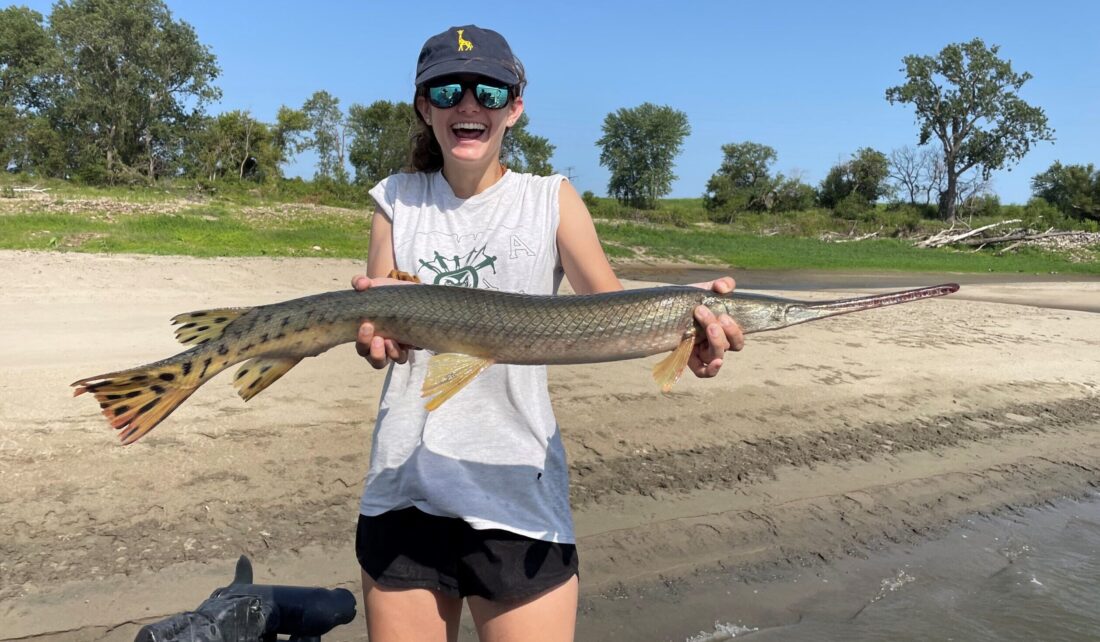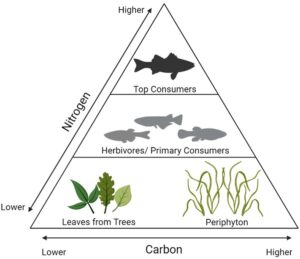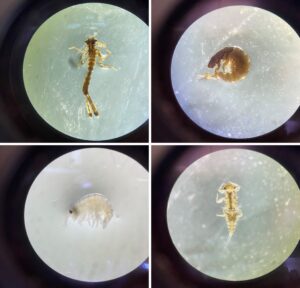
Meet Our Grad Student Scholars is a series from Illinois-Indiana Sea Grant (IISG) celebrating the students and research funded by our scholars program. To learn more about our faculty and graduate student funding opportunities, visit Fellowships & Scholarships.
Sydney McAndrews is a second-year graduate student in the Center for Fisheries and Aquatic Sciences at Eastern Illinois University in Charleston. McAndrews is assessing urban and agricultural stream restorations by surveying fish and macroinvertebrate populations. She is also building food webs using stable isotope analysis to understand the effects of stream restorations on aquatic ecosystems.
Changes in landscapes have detrimental consequences for aquatic ecosystems. Historic forests and prairie lands have been converted to agriculture and urban areas throughout much of the Midwest. Agriculture is the cause of nearly half of the water-quality impairment issues in surface water across the United States. In addition, our expanding cities and increased paved surfaces lead to higher runoff, causing flash flood events and elevated levels of pollutants in streams. Urban and agricultural streams have sparse vegetation surrounding them, reducing pollution uptake by plants and increasing soil erosion into the water. These modified landscapes often force sensitive species out of streams, allowing pollution-tolerant species to invade.
To reduce the impacts of urbanization and agriculture, stream restorations are constructed to improve stream function and health. The goals of stream restoration are to emulate natural stream conditions, improve water quality, and create better habitat for species of interest. Monitoring stream restorations is crucial to determine their effectiveness, yet many projects do not assess the success of restoration after construction. Therefore, there is a gap in our understanding of stream restoration benefits to aquatic ecosystems.
Sydney McAndrews, a graduate student at Eastern Illinois University, is monitoring the success of restorations in two Illinois streams: Kickapoo Creek in Charleston, an agricultural stream, and the Saline Branch in Urbana, an urban stream. Both streams experienced large fish kills due to separate chemical spills in the early 2000s. In response, habitat restorations were completed in Kickapoo Creek in 2010, and in the Saline Branch in 2020. Both restorations included the construction of physical structures to increase habitat and reduce erosion.
To examine if these restorations improved the ecosystems, in the fall of 2022 and 2023, McAndrews and her team conducted fish and macroinvertebrate (animals without a backbone that can be seen without a microscope) sampling in the streams to measure biodiversity. In addition to collecting several species of stream fish and macroinvertebrates, the team also collected ants, spiders, leaves and algae to create a food web of each stream using stable isotope analysis.

Nitrogen and carbon isotopic values change in a predictable way as you move along the food chain.
Food web interactions can be assessed to determine restoration benefits on stream health because they link populations to the functioning of the entire ecosystem. Streams and terrestrial land are connected, and energy and nutrients move between them. The incorporation of food web analysis allows for an in-depth evaluation of energy flow and nutrient cycling through an ecosystem. Monitoring the food web provides insights into the connection between water and land and establishes a foundation for ecosystem-based management. However, few studies have looked at the effects of stream restoration on aquatic ecosystems.
Stable isotopes are a tool to measure and compare the energy flow in ecosystems and are used as a proxy for stream health due to the predictable pattern between a consumer and its diet. As the saying goes, you are what you eat; the composition of a consumer’s tissues reflects their dietary intake over time. A comparison of the consumer’s isotopic ratios in its tissues relative to its potential food sources can be used to build a food web.
The most common isotopes collected in aquatic systems are carbon and nitrogen. Nitrogen isotope composition is used to determine the trophic position of a consumer, or how far up a consumer is in the food chain. Carbon isotope composition is used to analyze the resource base of energy sources supporting the food web and can be used to determine if herbivores are consuming terrestrial leaves, aquatic plants or algae. Healthy food webs have a diverse energy base, with more terrestrial and aquatic links and longer food chains. The food web complexity in aquatic systems can be compared to each other when coupling the results of both carbon and nitrogen isotopes. By monitoring changes in the food web, we can gain insights into diet shifts of individual species or changes in the structure of the entire food web.

Macroinvertebrates collected in the Saline Branch in Urbana, Illinois. Family identification in a clockwise rotation beginning with top left; damselfly, caddisfly, mayfly, and scud
The goal of this research is to use the Saline Branch and Kickapoo Creek restorations as case studies for the effectiveness of stream restoration. The objectives of this study are to (1) measure changes in biodiversity of the streams as a function of the restorations, and (2) compare the food web structures of urban and agricultural aquatic communities as a proxy to stream health in restored and unrestored sections of the Saline Branch and Kickapoo Creek.
McAndrews expects to find more complex aquatic food webs in the restored areas compared to the unrestored areas. Information gleaned from this study will aid in the implementation of effective restoration techniques in urban and agricultural streams. It is critical to monitor the success of costly restorative stream treatments and to allocate funds to projects that increase the resiliency of aquatic habitats. McAndrews’ research is novel in its approach to use food webs to measure restoration success, and she hopes it will lead to enhanced stewardship of urban and agricultural streams in Illinois and Indiana.
Illinois-Indiana Sea Grant is a partnership between NOAA, University of Illinois Extension, and Purdue University Forestry and Natural Resources, bringing science together with communities for solutions that work. Sea Grant is a network of 34 science, education and outreach programs located in every coastal and Great Lakes state, Lake Champlain, Puerto Rico and Guam.

